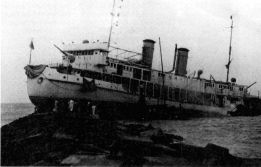The new gunboats were not a complete success, because none met the design characteristics so so frequently recommended by experienced China sailors. Excessive draft was the most important discrepancy: the two smallest, the Guam and Tutuilla, drew 6 feet, 4 inches, which barely permitted them to operate year-round on the upper Yangtze. The other four ships could steam only the upper river during the May-September period of "high water." As a result, as early as 1933 the Yangtze Patrol commander, Rear Admiral Y. S. Williams, requested construction of gunboats that would not be restricted by "excessive length and draft."
The six new gunships served on China's rivers throughout the 1930s, attempting to deal with the disruptive effects of the fractionalized Nationalist government and its struggles with the communists and the Japanese. The ships protected merchant steamers, rescued U.S. and other foreign citizens, and exerted a stabilizing influence along China's waterways. Although U.S. naval and diplomatic officers sought to carry out these tasks without interfering in the country's internal affairs, this was a forlorn hope, since the U.S. gunboats were interfering in China simply by being there.

The USS Luzon (PG-47) ran aground on the Woosung breakwater below Shanghai on her maiden voyage. After her yangtze service, in December 1941 she steamed from China to the Philippines, where she was scuttled in Manila Bay when Corregidor fell. Salvaged by the Japanese as the gunboat Karatsu, she was sunk the submarine USS Narwhal (SS-167) in 1944.
The war with Japan claimed four of the gunboats. The Panay, sank in December 1937, was the U.S. Navy's first World War II casualty. The Luzon, Mindanao, and Oahu steamed from China to the Philippines in early December 1941. The Oahu was sunk by Japanese gunfire near Corregidor in May 1942, while the Mindinao was scuttled by her crew after being immobilized by Japanese bombs that same month. The Luzon also was scuttled in Manila Bay when Corregidor fell in May, but she was salvaged by the Japanese, who operated the gunboat as HIJMS Karatsu until she was sunk by the submarine Narwhal (SS-167) in 1944.
The Guam was renamed the USS Wake (also PG-43) in January 1941, so Guam could be used for a new battlecruiser. The Wake was considered too small for the
The Tutuilla steamed up the Yangtze to the wartime capital of Chungking when the Japanese attacked Pearl Harbor. She was transferred to the Chinese Navy in 1942 and renamed Mei Yuan. The ship served with the Nationalists until 1948, when she was scuttled at Shanghai as the communists threatened the city.
Japan's 1941 aggression marked the end of the U.S. gunboat presence in China. The Japanese Navy destroyed the Asiatic Fleet and the gunboats of the Yangtze Patrol met varying fates. The U.S. Navy returned to China in 1945, but the "unequal treaties" had been revoked and the foreign presence drastically reduced. An era had ended for the Navy with the loss of the gunboats in 1941. The Asiatic Fleet and Yangtze Patrol existed thereafter only in myth and legend.